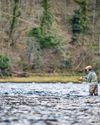
When fish-crazy Professor Henry Hughes of Western Oregon University came to England, his rods and reels stashed optimistically under Christmas presents for his wife’s family, this was the only escape he could muster, the first week of the New Year. But what can you catch in January, apart from the flu? We’d met by email when Hughes wanted to include an old story I’d written about chasing bonsai sharks in The Wash in an anthology of fishing writing he was working on. He was hoping I could take him on a similarly batty adventure. And now all I really had to offer were pike. Good in theory. The creaking-creel school of pike angling paints a romantic picture of hunting Esox in the depths of winter, galoshes crunching frostbitten grass, icicles on the nose and vast pike swirling menacingly under a duvet of mist. But in my experience, on those arse-numbingly frigid days of angling folklore, pike are impossible. They are nutritionally celibate, fishy Trappists, sunk to their midriffs in ooze and weed, contemplating only the inside of their dull, fishy brains and locked in semi-hibernation. The only way to catch one on such a day is to dangle a rotten herring infront its face for 12 hours. And I don’t fish with bait. There’s grayling, too, of course. Just like pike, they slow down in the depths of winter and, just like pike, are so much better when you can see them and stalk them. In October, for example.
TEMPERING EXPECTATIONS
I tried to temper Hughes’ expectations. We’d have to hope for a warm spell, I said. We might have to use plugs and spoons. And there are no grayling in Norfolk. None of this fazed him. Not at all. He’s from Oregon, where men are men and sturgeon are nervous. Hughes’ luggage jingled with fishy Oregonian hardware as I met him off the bus at King’s Lynn. It was New Year’s Eve. We drove the long way home, reconnoitring the local dykes and drains.
This story is from the {{IssueName}} edition of {{MagazineName}}.
Start your 7-day Magzter GOLD free trial to access thousands of curated premium stories, and 9,000+ magazines and newspapers.
Already a subscriber ? Sign In
This story is from the {{IssueName}} edition of {{MagazineName}}.
Start your 7-day Magzter GOLD free trial to access thousands of curated premium stories, and 9,000+ magazines and newspapers.
Already a subscriber? Sign In

Rory Stewart - The former Cabinet minister and hit podcast host talks to Alec Marsh about the parlous state of British politics, land management and his deep love of the countryside
The gently spoken 51-year-old former Conservative Cabinet minister is a countryman at heart. That's clear: he even changes into a tweed waistcoat for the interview, which takes place at his London home and begins with a question about his precise career status. Having resigned from the Commons and the Conservative Party in 2019, the former diplomat and soldier has reinvented himself, first with an unconventional but promising run as an independent for the London mayoralty (abandoned because of COVID19 in 2020) and then as a media figure, co-hosting one of the country's most popular podcasts, The Rest Is Politics, alongside Alastair Campbell, the former Labour spin doctor.

Fodder
Local fare with the feel-good factor.

Celebrating the game changers
Once served only in the traditional manner, the fruits of our forays now find their way into all manner of diverse and delicious dishes, say Neil and Serena Cross

The first civil engineer
John Smeaton left an indelible mark on the field of engineering and, three centuries after his birth, his legacy remains as strong as ever

School spirits
From grey ladies and ghostly gardeners to more malign entities, public schools are a rich repository of unnatural phenomena

'A long way from Piccadilly or Pall Mall'
Marking 150 years since the birth of Sir Winston Churchill, Dr Conor Farrington explores this eminent statesman’s often-overlooked 1907 tour of British East Africa: a journey rich with enchanting natural beauty and sporting adventure

Top of the pups
Canines in all their guises were celebrated at The Field Top Dog Awards lunch at Defender Burghley Horse Trials whether eager on the peg, patient at home or perpetually making mischief

Angling for success
It’s never too early to shape up for next season’s salmon and trout, and these top fishing schools are here to help

Talking scents
The canine nose is an astonishingly complex piece of biotechnology that man has harnessed for sustenance and sport for thousands of years

Wall-to-wall excitement
Criss-crossed by formidable drystone walls, the High Peak Harriers’ scenic country provides a day out with an exhilarating difference